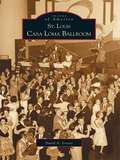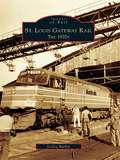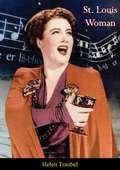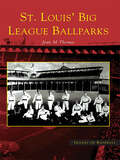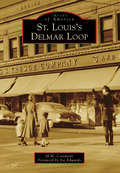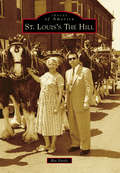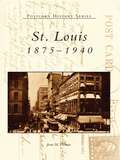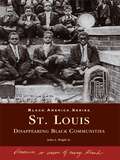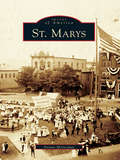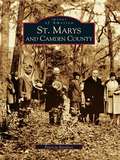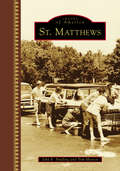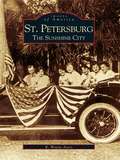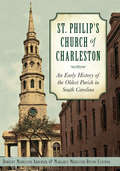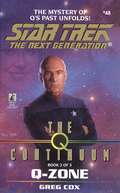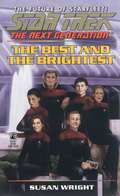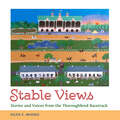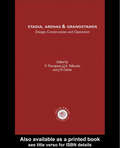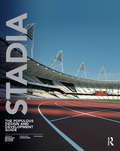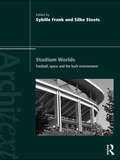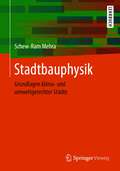- Table View
- List View
St. Louis Casa Loma Ballroom
by David A. LossosIn 1927, on the northeast corner of Cherokee and Iowa Streets in south St. Louis, a multistory, multipurpose building was erected. Retail shops and a bowling alley occupied the first floor, while upstairs was a place that defied the imagination of someone driving by in their brand new Model T Ford. Today, that upstairs space, with its lofty ceiling, huge maple tongue-in-groove dance floor, and wraparound balcony, is the Casa Loma Ballroom--St. Louis' last grand ballroom. Today, one gets the feeling that the ghosts of the big bands and the vocalists still linger there--and with good reason. Just about everybody who was anybody played there at one time or another. Ol' Blue Eyes himself, before he was the idol of millions, received just a meager "Featured Singer, Frank Sinatra" note at the bottom of the Casa Loma bill the night he played with the Harry James Orchestra.
St. Louis Gateway Rail: The 1970s
by Lesley BarkerThough the city of St. Louis is located on the Missouri side of the Mississippi River, for the railroads, the St. Louis Gateway extends into Illinois, north and south along both sides of the river. Two factors conspired against St. Louis's aspiration to become the preeminent rail center of the 19th-century American Midwest: there was no bridge across the Mississippi, and Missouri's loyalty to the Union during the Civil War was suspect. Chicago beat out St. Louis to attain the region's top railroad billing. Fast forward to the 1970s, when the Gateway Arch, dedicated in 1968, redefined the St. Louis riverfront and when the St. Louis Union Station closed to rail service. The 1970s was a decade of railroad debuts--Burlington Northern, Illinois Central Gulf, Family Lines--and a decade of railroad demises--Rock Island and Frisco. It signaled the end of a century of rail domination of the American transportation scene.
St. Louis Woman (Opera Biographies Ser.)
by Helen Traubel Richard G. HublerThis charming autobiography captures the life story of a fascinating woman: a Missouri girl-turned-world-class soprano who remained true to her roots through it all.Born and reared in St. Louis and proud of her origins, Helen Traubel grew up in a modest German-American family. She spent her teens and twenties singing with church choirs and quartets in the city, studying under first- rate teachers. She did not leave Missouri for New York until she was in her early thirties. Although she replaced the great Kirsten Flagstad at the Metropolitan Opera, she refused to confine herself to singing before elite crowds and prided herself on reaching a larger, more general audience via nightclubs, radio, television, and theater.St. Louis Woman is filled with candid and amusing stories as full of zest as Traubel herself. One such story details her audition for the Ford Hour, during which she suffered a terrible case of poison ivy, and the booth technicians interrupted her performance with laughter. Furious, she announced she would sing no more and started to leave. Without explanation, the technicians asked her to continue. Traubel later discovered that the higher-ups had called down to the technicians demanding they stop playing the Flagstad record and let that kid sing.The qualities that made Traubel such a notable individual are captured in this entertaining book. Her strong, independent character shines through. Outspoken and at times brutally honest, Traubel recounts her experiences at the Met, as both a popular performer and a teacher. She tells of exasperating moments when she was coaching famous pupil Margaret Truman. This is not a fact-laden examination of the singer’s Wagnerian repertory or a study of high opera; rather this engaging book introduces the reader to a nationally renowned performer who, despite her unmatched talent, retained her hometown identity and lived her life as a St. Louis woman.
St. Louis' Big League Ballparks (Images of Baseball)
by Joan M. ThomasBaseball came to St. Louis before the dawn of the major leagues. It was a gentleman's game, a simple summer pastime, and its popularity grew as the city evolved. Local amateur teams proliferated, and interest in forming a team of professionals resulted in two such St. Louis teams in 1875, the Brown Stockings and the Red Stockings. The Browns and Reds played their home games at separate parks, the Grand Avenue Grounds and Red Stockings Park. The first fully professional game of baseball held in St. Louis took place at the latter. Very few modern fans are aware of this, or of these parks' locations. Moreover, there was a time early in the twentieth century when St. Louis supported not just two, but three major league teams, each with its own ballpark. This book is intended as a keepsake of the stadiums and playing fields of St. Louis' baseball past.
St. Louis's Delmar Loop
by M. M. Costantin Joe EdwardsIn 1902, magazine publisher Edward Gardner Lewis needed greater space for his thriving business, then based in downtown St. Louis. He headed west, out Delmar Boulevard a mile past the city line, and bought five acres of open land adjacent to the loop in the trolley tracks that sent the 10D streetcar back downtown. By 1903, Lewis was building a complex that included the Woman's Magazine Building, a five-story octagonal tower with an eight-ton searchlight in its dome. In 1906, University City was incorporated, and Lewis became its first mayor, serving three terms. In 1913, Lewis went west again, this time to found the utopian colony of Atascadero, California. His octagonal dazzler is now University City's City Hall. In 2007, in its first such list, the American Planning Association named the Delmar Loop one of the country's "Great Streets"--it's a long story.
St. Louis's The Hill
by Rio VitaleThe Hill was named for its proximity to the highest point in St. Louis. Italians, mainly from Northern Italy, immigrated to the area starting in the late 1800s; however, by 1910, Sicilians were also immigrating to the Hill. Agencies in Italy were employed by mining companies and other industries to help Italian citizens gather all the required documentation for immigration. Italians came to the Hill because of its proximity to the factory and the mines and because it was a district that allowed them to purchase land and build a home. The Parish of St. Ambrose was founded 1903. After the original church was destroyed by fire, the new church was completed in 1926. The Hill has been home to some of St. Louis's nationally known residents, including baseball heroes Joe Garagiola and Lawrence "Yogi" Berra.
St. Louis: 1875-1940 (Postcard History)
by Joan M. ThomasThe "beautiful city" described by early 20th century picture postcard senders still exists. The vintage postcard images presented here take you on a tour of St. Louis' burgeoning days, where you will revisit the grand architecture and neighborhoods of the early part of the last century. See Union Station in its original incarnation as a train station. Witness the grandeur of the 1904 World's Fair held at forever beautiful Forest Park. Plus, savor the charm of the city's many other parks, such as Lafayette Park, the site where baseball was first introduced to St. Louis. You will visit the thoroughfares of downtown St. Louis before it became necessary to rebuild and renovate. Finally, visit favorite places like Soulard Market, which have thrived from the beginning, maintaining a connection between the past and the present.
St. Louis: Disappearing Black Communities (Black America Series)
by John A. Wright Sr.Since the founding of St. Louis, African Americans have lived in communities throughout the area. Although St. Louis' 1916 "Segregation of the Negro Ordinance" was ruled unconstitutional, African Americans were restricted to certain areas through real estate practices such as steering and red lining. Through legal efforts in the court cases of Shelley v. Kraemer in 1948, Jones v. Mayer in 1978, and others, more housing options became available and the population dispersed. Many of the communities began to decline, disappear, or experience urban renewal.
St. Mary's County
by Karen L. GrubberFor nearly four centuries, St. Mary's County has been called "the land of pleasant living." The county's fertile fields and pristine waters invite visitors and natives alike to revel, relax, and renew. As the "Mother County" of Maryland, St. Mary's has a rich written history dating from 1634, when George and Leonard Calvert established the first American settlement founded on the principle of religious tolerance. After surviving British raids during the War of 1812 and divided loyalties in the Civil War, the county leapt into the modern era when the US Navy established Naval Air Station Patuxent River, the Navy's premier flight test center and test pilot school. Today, millions of Americans trace their roots to Southern Maryland and are welcomed home as "Sons and Daughters of Old St. Mary's."
St. Marys (Images of America)
by Dennis McgeehanLocated in Elk County atop the Allegheny Mountains, Sancta Marienstadt (St. Marys) was founded in 1842 on the feast day of Mary. Establishing St. Marys as a refuge to preserve their German Catholic roots, the hardy pioneers of the area eventually embraced a multiethnic, progressive cityscape. Early settlers farmed and developed natural resources. When the extractive industries of timber, coal, and clay were exhausted, the town could have withered away. Instead, the industrious people turned to the newtechnologies of carbon and powdered metal. St. Marys flourished, becoming a leader in the world in these fields, and was labeled the "Carbon City." St. Marys recounts the success of this experiment through photographs from the St. Marys and Benzinger Township Historical Society, illustrating the many paths taken by the people of St. Marys to realize the faith of their founders.
St. Marys and Camden County
by Patricia BarefootBounded on the north by the Little Satilla River from neighboring Glynn County and on the east by the Atlantic Ocean, Camden County's southern boundary at the St. Marys River separates Georgia from Florida. Dating from a 1766 land grant, port of St. Marys and Camden County have faced a challenging past, present, and future. Camden's growth and development have been driven by businessmen, adventurers and opportunists, determined "wild swamp Crackers," and hardy, self-reliant, God-fearing men and women.Accompanied by Jonathan Bryan, a planter with an insatiable appetite for virgin tracts of land, Georgia's third and last Royal Governor James Wright visited Buttermilk Bluff in June 1767 and envisioned a city. St. Marys was born, and its street names reflect the surnames of the 20 founding fathers. While the county seat was removed from a quaint St. Marys on more than one occasion, today, the garden spot of Woodbine serves as the seat of county government. Formerly the rice plantation of J.K. Bedell, this small city shares a symbiotic relationship with port of St. Marys and the "City of Royal Treatment" at Kingsland. The history of the county, with its three main towns as well as the outlying, rural areas, unfolds in striking photographs from days gone by. Preserved within the pages of this treasured volume, images reveal Camden and its people in times of tragedy and triumph.
St. Matthews
by John E. Findling Tom MortonSt. Matthews, once a prominent neighborhood of Louisville, is now a fourth-class city within metro Louisville. The first settlers came to the area in the 1780s, and for more than a century St. Matthews was largely an agricultural area where farmers specialized in growing potatoes. By 1900, a commercial district had grown at the intersection of several roads, known locally as the Point, and the land devoted to farming was gradually taken over by new commercial and residential development. After the great flood of 1937 and World War II, Shelbyville Road, the principal east-west street in St. Matthews, was the site of a commercial boom that included malls and other shopping centers, automobile dealerships, and a wide variety of other businesses. Today, the town of St. Matthews is a vibrant economic and cultural center that attracts people from all parts of metropolitan Louisville.
St. Petersburg's Piers
by Nevin D. SitlerCommerce, tourism, recreation, and even the quest for eternal youth were the primary incentives for building piers along St. Petersburg's downtown waterfront as early as 1854. For more than 160 years, developers and entrepreneurs pushed wooden or concrete structures from the shoreline to the deeper waters of Tampa Bay. Railroads were behind the early development, allowing cargo loads to be transferred from ship to rail with the least amount of effort. A large and profitable fishing industry evolved. Electrically powered trolley cars shuttled tourists to and from cruise ships. Promoters built bathhouses, spas, and bait houses to entice locals and visitors, and casino gathering halls of various, often controversial, styles were proposed, built, destroyed, loved, and detested. Competing piers were built only 10 feet apart. Mother Nature's elements, including a hurricane, and politics ravaged most of the remaining structures.
St. Petersburg: The Sunshine City
by R. Wayne AyersIn the early 1900s, St. Petersburg, located on Florida's sunny Gulf Coast, was a place where dreams came true, where fortunes were won, and where thousands came to bask in the city's golden glow. "The Sunshine City" became its nickname and the advertising mantra that helped catapult St. Petersburg from a sleepy backwater of Tampa and a struggling rail stop to one of the nation's most popular tourist destinations. By the 1920s--often referred to as Florida's boom era--St. Petersburg saw fast and furious growth as the city's most significant institutions, buildings, and attractions came into being. Developers and promoters lured countless settlers and tourists from across the country by touting the city's many virtues and its perpetual sunshine. Almost overnight, St. Petersburg was transformed into a popular tourist mecca with a bustling downtown and waterfront, picturesque residential neighborhoods, lush parks and gardens, and the all the attractions of the day. This fascinating time was documented in both word and image by visitors, new residents, and the energetic players that made St. Petersburg boom.
St. Philip's Church of Charleston: An Early History of the Oldest Parish in South Carolina
by Margaret Middleton Eastman Dorothy Middleton AndersonSt. Philip's Church was commissioned shortly after the Carolina colony was founded in 1670. Because the Church of England was the established church, St. Philip's tried to meet the spiritual needs of the early settlers and also was responsible for oversight of elections, education and social services in everything from healthcare to disaster relief. St. Philip's churchwardens and vestry enforced morality laws and levied taxes. The colony's first state funeral--that of Governor Robert Johnson--took place in the church, as did that of the controversial, one-time vice president, Senator John C. Calhoun. Buried in the churchyard are Founding Fathers, pirate hunters, war heroes, statesmen and even the unfortunate victim of a sensational murder. This book recounts the early years of St. Philip's Church, the people who walked its aisles and some of the early religious conflicts that shook the community. Authors Dorothy Middleton Anderson and Margaret Middleton Rivers Eastman outline the fascinating history of the first church in the new colony.
St: The Q Continuum Book 2
by Greg CoxThe Q Continuum is an extradimensional domain in which Q and others of his kind exist in immortality. Although immensely powerful and intelligent, they require the stimulus of novelty to maintain their vitality hence their interaction with other species. While the Enterprise struggles to survive an alien onslaught, Captain Picard has been kidnapped by Q and taken on an astounding journey back to that immeasurably distant moment when the Continuum faced its greatest threat. But far more is at stake than simply the mysteries of the past, for an ancient menace is stirring once more, endangering the future of the galaxy, and neither Q nor Starfleet may be able to stop it.
St:the Best And The Brightest (Star Trek)
by Star Trek{\rtf1\ansi\ansicpg1252\deff0{\fonttbl{\f0\froman\fcharset0 Times New Roman;}{\f1\fnil\fcharset0 Arial;}} \viewkind4\uc1\pard\sb100\sa100\lang2057\f0\fs24 Every year, Starfleet Academy in San Francisco attracts many of the most talented and ambitious young people in the Federation. They come from all over the Alpha Quadrant, from hundreds of worlds and species, to prepare themselves for the challenges of the final frontier. \par Meet a new generation of cadets: a newly joined Trill just beginning the first of many lives; a Bajoran Vedek who finds himself torn between his vows and an unspoken love; a reckless young man fond of pushing the limits; a feline alien raised among humans; a brilliant but immature young woman with a lot to learn; and a native-born Earth woman with a talent for engineering. \par Together they will learn about courage, life, teamwork, and themselves. Their future is just beginning -- but one of them will not survive! \par \pard\f1\fs18 \par }
Stable Views: Stories and Voices from the Thoroughbred Racetrack (Folklore Studies in a Multicultural World Series)
by Ellen E. McHaleStable Views offers an inside look at the thoroughbred racing industry through the words and perspectives of those who labor within its stables. In more than fourteen years of field research, Ellen E. McHale has traveled throughout the Eastern Seaboard, Kentucky, and Louisiana to gather oral narratives from those most intimately involved with racing: the stable workers, exercise riders, and horse trainers who form the backbone of the industry. She interviewed workers at Saratoga, Belmont, Tampa Bay Downs, Keeneland, the Evangeline Training Center in Louisiana, and the Palm Meadows Training Center in Florida.Workers within all sectors of the thoroughbred world have long histories of involvement in the racing industry, with many individuals shifting occupational roles throughout their lifetimes. The thoroughbred racetrack operates as a multicultural workplace that relies upon apprenticeship and mentoring. Many workers speak to the history, the joys, the hardships, and the miracles of horse racing along with the changes that they have experienced through their long careers. Included in the book are discussions about luck, the occupational language of the racetrack, race and gender, and recent changes in the industry, all in the words and voices of the stable workers.
Stack & Cut Hexagon Quilts: Mix & Match 38 Kaleidoscope Blocks & 12 Quilt Settings
by Marci Baker Sara NewphewSerendipitous designs that appear like magic Show off your large-scale prints and add a WOW factor to your quilts. Take advantage of the surprising designs that appear as you stack and cut triangles, diamonds, flat pyramids, gem shapes, and more. Each beautiful block design frames a unique kaleidoscope hexagon, for stunning results! Select from 38 hexagonal blocks, 7 setting triangles, 12 quilt layouts, and 5 pieced borders, plus get Sara and Marci’s tips for picking the best fabric for this technique, lining up stacked repeats, and cutting shapes to take advantage of large-scale print fabric. Fair warning: you may never want to make a quilt any other way again! • Love your large-scale prints, but don’t know how to use them? Display them in large central stars and hexagons for amazing, striking designs • Endlessly unique quilts made from 60° blocks using stacked repeat fabrics • Follow up to best-selling Serendipity Quilts and Doubledipity: More Serendipity Quilts
Stacked Decks: The Art and History of Erotic Playing Cards
by The Rotenberg CollectionThe Rotenberg Collection is one of the world’s largest archives of vintage erotica, with more than 20,000 erotic playing cards in its holdings—and Stacked Decks highlights the best of the best. Within these pages, readers will discover illustrated cards dating back to 1835, dazzling pin-up portraits from renowned artists such as Gil Elvgren, cards with instructions for promoting a healthy marriage, oversized cards, miniature cards, round cards, square cards, and comic cards. There are cards from Sweden, France, and the United Kingdom; cards from Africa to Asia and beyond. And of course, there are women. There are models, flappers, and strippers; there are blondes, brunettes, and redheads. There are women holding guns. Women in sports cars. Women wearing sombreros and pith helmets. Women encountering large exotic animals. Women reclining on shag carpets. Women dressed like Eskimos. Women posing in ways that defy description—you simply have to see for yourself. So what are you waiting for? Ante up and turn the page!
Stacking the Deck
by Bryan Berg Thomas O'DonnellWritten by the holder of several Guinness World Records for cardstacking, this is the first complete, fully illustrated guide to the art of building mind-boggling, multilevel structures with ordinary playing cards. In Stacking the Deck, Bryan Berg reveals the secret to successful cardstacking with his simple four-card-cell structure and expanded grid techniques. Using illustrations and step-by-step instructions, he guides readers on to more elaborate -- and incredibly strong -- creations. He covers a wide range of architectural styles, from classic to whimsical, and various types of structures, including pyramids, shrines, stadiums, churches, an oil derrick, and even the Empire State Building. Since first setting the height record in 1992, Bryan's built awe-inspiring card models of a Japanese shrine, the Iowa State Capitol building, Ebbets Field, and his latest tower, which is more than twenty-five feet tall! This book includes photographs of some of these amazing pieces, illustrating just how appealing and enduring a "house of cards" can be. Stacking the Deck will inspire everyone from youngsters experimenting with their first deck of cards to adults, who can create their own private skyscrapers. Once you've read Stacking the Deck, you'll never look at a deck of cards the same way again.
Stadia Arenas and Grandstands: Design, Construction and Operation
by P. D. ThompsonThis book covers the International Concrete Society Conference held at the Cardiff International Arena and will be of interest to architects and planners, facility managers and consultants in the fields of engineering, environmental control and services and leisure managemnet, media facilities and to client organizations planning major sports and '
Stadia: The Populous Design and Development Guide
by Rod Sheard Geraint John Ben VickeryIn this fully updated and redesigned edition of the essential and long-established Stadia, the authors offer their unrivalled expertise to all professionals who commission, plan, design, and manage high-quality sports venues. Ideas about the design and use of stadiums continue to evolve and this fifth edition includes the latest developments in the field. Including updated chapters on sustainability, masterplanning and services, a new chapter on branding activation, and new global case studies, the fifth edition of Stadia is the ultimate guide to all aspects of stadium design, from local club buildings to international showpieces. In addition to a wide array of international case studies, the authors draw on the experience of the design firm Populous who in recent years delivered the 2010 Yankees Stadium in New York; the 2010 Aviva stadium, Dublin; the 2004 Benfica stadium, Lisbon; the 2010 Soccer City FNB Stadium, Johannesburg; the 2012 Marlins Park, Miami; and the 2012 new Olympic Stadium, London.
Stadium Worlds: Football, Space and the Built Environment (Architext)
by Sybille FrankAnalyzing football as a cultural practice, this book investigates the connection between the sport and its built environment. Four thematic sections bring together an international multi-disciplinary range of perspectives with particular focus on the stadium. Examples from architectural design, media studies and archaeology are used while studying advertising, economics, migration, fandom, local identities, emotions, gender, and the sociology of space. Texts and case-studies build up this useful book for lecturers and researchers in sociology, cultural studies, geography, architecture, sport and environment.
Stadtbauphysik: Grundlagen klima- und umweltgerechter Städte
by Schew-Ram MehraDas Lehrbuch stellt die Aspekte und Aufgabengebiete der Stadtbauphysik dar, beschreibt den Zusammenhang zwischen Mensch, Bebauung sowie Umwelt und zeigt die stadtbauphysikalischen Besonderheiten in Städten auf. Es gibt dem Leser Werkzeuge für die Analyse und Umsetzung einer klimagerechten Stadt zum nachhaltigen Klimaschutz an die Hand.
